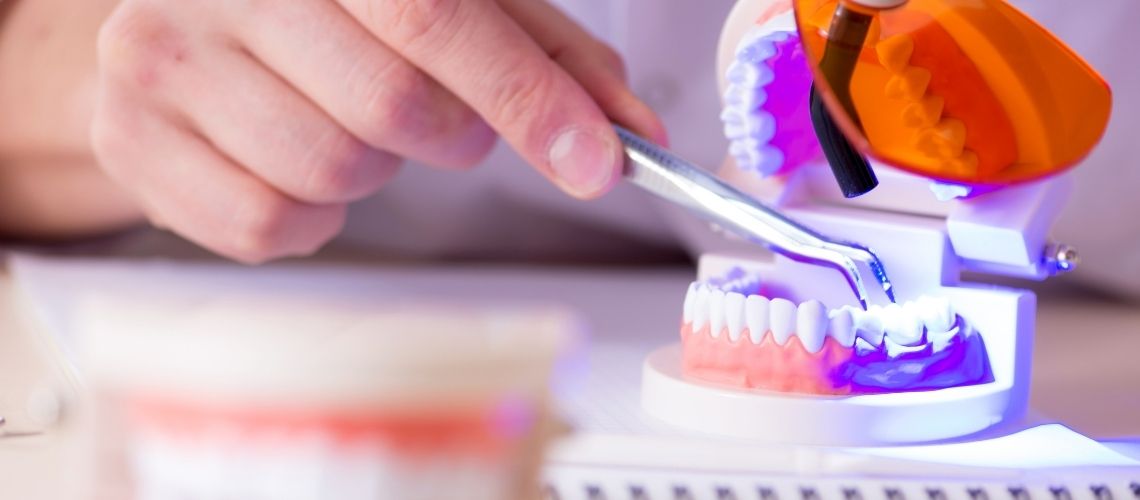Tartar cleaning is an important part of oral health care. This procedure, performed by dentists, cleans hardened plaque accumulated on the tooth surfaces. Over time, brushing and flossing may become insufficient. In this case, professional intervention is essential. If tartar is not removed, it can lead to serious problems such as gum disease. Therefore, regular dental check-ups and cleanings are essential to prevent these complications.
Things to Know About Tartar Cleaning
Tartar is hardened dental plaque that forms above and below the gum line. Plaque accumulates in everyone’s mouth over time. If this plaque is not regularly cleaned, it turns into tartar. Tartar formation is due to insufficient attention to oral hygiene. Additionally, genetic factors can also affect the rate of tartar formation. This hard structure seen on the teeth cannot be cleaned with a toothbrush or floss. However, it can be removed by dentists using special tools.
Points to consider during the tartar cleaning process:
- Tartar can damage the gums.
- Removing tartar is important for maintaining oral health.
- Tartar helps prevent gum disease.
If tartar is not cleaned in time, it can lead to gum disease and other oral health problems such as:
- Gum recession
- Loose teeth
- Tooth loss
The Chemical Composition of Tartar
Tartar has significant effects on oral health. The basis of this structure consists of residues of dead bacterial cells. These residues combine with minerals found in saliva over time and harden. The mineralization process accumulates layer by layer on the tooth surface. The main components of these accumulations are:
- Calcium phosphate
- Calcium carbonate
- Magnesium phosphate
These components play a key role in the formation of tartar’s hard and sticky structure. The accumulation of these minerals results in structures that cling tightly to the tooth surfaces and gum line.
Symptoms of Tartar on Teeth
Tartar manifests itself through visible changes in the mouth. Yellow, brown, or black discolorations appear on the tooth surfaces. These stains are due to mineral deposits on the tooth surfaces. This condition is known as halitosis and is an indication of the presence of tartar. In addition, there are noticeable inflammations in the gums:
- The gums appear red and swollen
- They are sensitive
- Bleeding often occurs
These symptoms indicate the formation of hard, crust-like layers on the teeth. These layers can damage the structure of the teeth over time.
The Relationship Between Tartar and Bad Breath
Tartar can cause halitosis (unpleasant mouth odor). It usually accumulates between the teeth and gums. The bacteria and food residues that accumulate in these areas:
- Trigger bad breath.
- Leave a bad taste in the mouth.
Especially the small pockets between the teeth and gums can become a breeding ground for bacteria. If tartar is not cleaned, it can negatively affect your oral health and cause a constant bad breath problem.
Factors Contributing to Tartar Formation
There are certain conditions that increase the formation of tartar. First of all, a person should brush their teeth at least twice a day and floss daily. Otherwise, food residues and bacteria that accumulate on the tooth surfaces accelerate the formation of plaque. If teeth are not cleaned regularly, these plaques harden over time and turn into tartar.
- Excessive consumption of sugary foods and drinks is another risk factor for tartar formation. Especially carbohydrate-rich foods such as bread and pasta stimulate the formation of plaque on the teeth.
- Smoking or using tobacco products reduces blood circulation in the gums, which hinders healthy oral hygiene.
- Braces allow food residues and bacteria to easily accumulate on the tooth surfaces.
Health Problems Caused by Tartar Formation
Not cleaning tartar can have serious consequences for oral and dental health. The hard layer that accumulates on the teeth provides a breeding ground for bacteria. Therefore, issues such as gum disease become inevitable. Here are the main health problems caused by tartar accumulation:
- Gingivitis: Redness, swelling, and bleeding of the gums can occur.
- Gum recession: The roots of the teeth become exposed, and the gums recede.
- Cavities: Cavities occur on and between the tooth surfaces.
- It can lead to general health problems.
Such problems can lead to tooth loss and broader oral health issues.
Tartar Treatment Methods
Tartar is safely removed by dentists using special tools. Since tartar accumulation cannot be cleaned by itself, professional help is necessary. During tartar cleaning, special tools are used to carefully remove the tartar from the tooth surfaces. This ensures that the teeth are cleaned without damage. In addition, your dentist may recommend various treatment methods depending on the intensity of the tartar:
- Teeth cleaning: Deep cleaning of tartar and plaque on the tooth surfaces.
- Gum disease treatments: Cleaning of tartar around the gums and improving gum health.
Both methods are crucial to protect your oral health and keep your teeth free from diseases.
The Process of Tartar Cleaning
Tartar cleaning is the process of removing hardened plaque from the tooth surfaces. Dentists use special tools during this process. These tools are used to remove plaque and tartar from the teeth. Additionally, floss is used to clean the spaces between the teeth. Finally, the teeth are polished with a special cap and toothpaste, aiming to make the teeth cleaner and healthier. These cleanings, recommended every six months, are of great importance for maintaining dental health.
- Cleaning the teeth: Plaque and tartar are removed with special tools.
- Use of floss: The spaces between the teeth are thoroughly cleaned.
- Polishing process: The tooth surfaces are polished with a special cap and toothpaste.
- Removal of supragingival stains using an Airflow device.
This routine helps prevent oral health problems such as cavities and gum disease.
Treatment Methods for Gum Disease
If tartar is not treated, it can cause serious damage to the gums. Your dentist may recommend various treatment methods to stop the progression of gum disease. These treatments are particularly aimed at cleaning tartar accumulated in areas unreachable by a toothbrush and floss. First, scaling and root planing are performed by the dentist. This process smooths the tooth surfaces.
- Scaling and root planing: Smoothing the tooth surfaces.
- Osseous surgery: Reduces the depth of gum pockets.
- Laser periodontal therapy: Uses laser energy to kill bacteria under the gums.
Each treatment method is applied to protect gum health and prevent further complications.
Methods to Prevent Tartar Formation
Preventing tartar formation is one of the basic ways to protect oral health. Regular dental care helps avoid tooth decay and gum disease. Effective methods to prevent tartar formation include:
- Brush your teeth two to three times a day with fluoride toothpaste and a medium-bristle toothbrush. This reduces plaque formation and supports dental health.
- Floss daily. This cleans the food residues and plaque between the teeth. Two options are provided:
- Traditional floss
- Small interdental brushes (if there is gum recession)
- Rinse twice a day with an antibacterial mouthwash (usually alcohol-based. Use the alcohol-free variant if pregnant). This kills harmful bacteria in the mouth and prevents plaque accumulation.
- Tobacco products increase tartar formation; therefore, avoid smoking and tobacco products.
- It is important to see your dentist regularly. Biannual check-ups and, if necessary, professional cleanings serve as a preventive measure when home care is insufficient.
What Problems Can Arise If Tartar Is Not Cleaned?
If tartar is not cleaned, various health problems can occur in the teeth and gums. First of all, tartar will erode the enamel, making the teeth more sensitive. This condition also paves the way for cavities. Additionally;
- Causes swelling and bleeding of the gums
- Leads to problems such as bad breath, which negatively affects social life
- Causes a stained and unattractive appearance of the teeth
Such health problems directly affect the quality of a person’s daily life.
Frequency of Visits for Tartar Cleaning
Each individual’s oral health status is different, and this determines the frequency of tartar cleaning. Some people accumulate plaque and tartar faster than others. This condition is usually associated with a person’s genetic makeup and lifestyle. For most people, the standard recommendation is to see a dentist every six months. However, the following situations should be considered:
- People at high risk of tooth decay
- People prone to gum disease
These individuals should schedule more frequent dental visits. The dentist will recommend a maintenance program based on personal oral health.
Plaque and Tartar: Basic Differences
Dental plaque is a yellowish, sticky film produced by bacteria in your mouth by feeding on sugars from food. It accumulates on the tooth surface and can be cleaned with regular brushing and flossing. Tartar, on the other hand, is the hardened form of dental plaque and has a more permanent structure. Initially, tartar is yellow in color, but over time it darkens and forms a hard layer on the teeth. Unlike dental plaque, tartar cannot be removed with home oral hygiene methods. It can only be removed by a dentist using special tools. These basic differences between plaque and tartar emphasize the importance of oral care.
- Dental plaque: can be removed with regular cleaning.
- Tartar: can only be removed with professional cleaning.
Why Does Tartar Break Off the Tooth?
In some cases, tartar can break off the tooth. This usually occurs for the following reasons:
- The pressure exerted while chewing food,
- Excessive hard brushing.
The breaking of tartar causes rough and sharp areas on the tooth surface. In such a situation, it may be tempting to try to remove the tartar yourself. However, this can damage both the teeth and gums. These rough areas on the tooth surface can lead to more bacterial accumulation and harm oral health. If you notice that tartar has broken off from your tooth, the safest way to correct the situation is to consult a dentist. The dentist can safely and effectively remove the remaining tartar.
Causes of Black Tartar on Teeth
Black tartar is deposits that appear on the tooth surfaces and change color. This color change occurs due to the influence of certain substances on dental plaque. Especially;
- Smoking or using tobacco products
- Excessive consumption of tea and coffee
- Colorful drinks like red wine
contribute to this condition. These substances darken the color of dental plaque, leading to the formation of black tartar. Tartar that accumulates below the gum line can take on a darker color when mixed with blood. This is especially observed in individuals experiencing gum bleeding. These black stains on the teeth indicate not only an aesthetic problem but also potential health issues.
Frequently Asked Questions
How much does tartar cleaning cost?
The cost of tartar cleaning varies depending on several factors. Firstly, the dentist’s experience plays a significant role; more experienced dentists may charge higher fees. Additionally, the city where the treatment takes place affects the price, with fees typically being higher in larger cities. The pricing policies of the clinics also create differences. Furthermore, additional treatments that may be required before tartar cleaning can increase the overall cost. Therefore, each of these factors influences the final cost of tartar cleaning.
Does tartar cleaning hurt?
Patients usually do not experience pain during tartar cleaning. This procedure is typically performed without anesthesia and may occasionally cause slight discomfort. However, these sensations are generally not severe enough to cause significant discomfort. The patient’s comfort is prioritized during the procedure, and any pain experienced is immediately addressed. Tartar cleaning is considered a painless treatment method for most people.
How long does tartar cleaning take?
Tartar cleaning typically takes about 25-30 minutes. However, in some special cases, this process may take longer. Although this procedure is usually completed in one session, more than one session may be required for individuals with advanced gum disease. Therefore, the duration of the treatment may vary depending on the patient’s oral health.
Does tartar cause bad breath?
Yes, tartar can cause bad breath. The hard yellow layer that accumulates between the roots and gums creates an environment where bacteria can thrive. These bacteria play a significant role in the development of bad breath. Additionally, tartar can cause inflammation in the gums, leading to even worse odors. Regular cleaning by a dentist is effective in preventing bad breath. If tartar is not removed, the odor may worsen, causing discomfort in social situations.
Does tartar cleaning whiten teeth?
Tartar cleaning is not a teeth-whitening procedure. However, removing plaque and tartar makes the teeth appear cleaner and brighter. After the procedure, teeth look shinier and cleaner. A polishing treatment can further enhance the shine. Teeth whitening, on the other hand, changes the color of the teeth, making yellow teeth whiter. There is a clear distinction between tartar cleaning and teeth whitening.
Do lemon and salt clean tartar?
Lemon and salt are not recommended for cleaning tartar. The acidic nature of lemon can damage tooth enamel, leading to more dental problems over time. Salt can be abrasive enough to cause scratches on the tooth surface. Tartar cleaning is best performed by a dentist. Professional cleaning is the safest way to maintain dental health and prevent more serious issues. It is always better to consult a specialist rather than seeking home remedies for tartar.
How long after tartar cleaning can I eat?
After tartar cleaning, it is recommended not to eat for 2 hours. During this time, even water should not be consumed to protect the treated area. After 2 hours, you can start eating light meals. For the first 24 hours, both hot and cold foods and drinks should be avoided. It is advisable to eat soft foods during this period and avoid extreme temperatures.
Do the gaps between teeth close after tartar cleaning?
The gaps between the teeth that may appear after tartar cleaning are usually temporary. These gaps will start to close as the gums heal. During the first few days or weeks, the gums renew themselves, returning to their previous state of health. The gaps between the teeth will gradually become less noticeable.
Does tartar come back after cleaning?
Unfortunately, tartar can form again after cleaning. Therefore, it is important to have regular cleanings to maintain oral health. It is generally recommended to do this every six months. This helps prevent plaque buildup and gum disease, reducing the risk of tartar formation. Regular check-ups are necessary as it is difficult to completely prevent tartar.
Should I brush my teeth after tartar cleaning?
After tartar cleaning, brushing your teeth is recommended. However, in the first few days, brushing should be done gently to account for any sensitivity. The use of antiseptic mouthwashes can also be beneficial in maintaining oral health. Mild bleeding in the first few days is normal.
Does tartar cleaning thin the teeth?
No, tartar cleaning does not thin the teeth. Tartar is a hardened plaque that builds up on tooth enamel, and this buildup does not reduce the thickness of the teeth. During tartar cleaning, only this buildup is removed. The natural structure of the teeth is not damaged by this process.
What should be done to prevent tartar?
There are several important steps to prevent tartar formation. First, brushing teeth at least twice a day is essential. This regular cleaning reduces plaque buildup and prevents tartar formation. Using dental floss is also crucial. Dental floss helps clean food particles and plaque between the teeth, reducing the risk of tartar. Regular dental check-ups are also necessary.
Does tartar cause cavities?
Tartar does not directly cause cavities but can contribute to them indirectly. Tartar is a hardened layer of plaque on the tooth surface, which can damage the gums. When gum recession occurs, the tooth roots are exposed, increasing the risk of cavities. Bacteria that accumulate below the gum line can produce acids that erode tooth enamel, eventually leading to cavities.
How often should tartar cleaning be done?
Tartar cleaning is generally recommended every six months. However, if a person’s mouth and saliva are more prone to plaque and tartar buildup, this frequency may increase. Regular dental check-ups are recommended to maintain oral health.
Does the dentist clean tartar?
Yes, dentists perform tartar cleaning procedures. During this process, tartar, also known as calculus, is removed using special tools. This helps prevent gum disease. The dentist performs this procedure regularly to maintain oral health.

Dentist Handan Nohutcuoğlu graduated from Ege University Faculty of Dentistry in 1987. He has gained experience in various fields by working in many dental polyclinics throughout his career, combining his knowledge and experience. He continues to work at Hollywood Dental at the moment.









